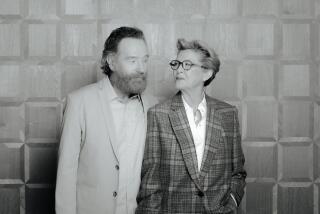Gaspar Noé invites you to ‘Enter the Void’
French filmmaker Gaspar Noé makes the kind of movies that require warnings.
His brutal 2002 revenge drama, “Irréversible,” arrived in theaters in England and Canada with a written alert about the possible side effects of a strobe-like sequence: “Some people may experience loss of consciousness or epileptic seizures when exposed to certain light effects or flashes of light.”
The writer-director’s 1998 debut feature, “I Stand Alone” — about a sociopathic butcher with incest and murder on the brain — carries an even less subtle warning. “Attention: You have 30 seconds to leave the theater,” a title card reads just before the drama’s shocking conclusion.
But after making his name by electrifying and antagonizing audiences, Noé’s experimental third film, “Enter the Void,” requires a different kind of disclaimer. A psychedelic odyssey of drugs and sex, it premiered to mixed reviews at the Cannes Film Festival last year, where it was nominated for the Palme d’Or. However, unlike Noé’s previous features, nobody stormed out or fainted at screenings. So audiences should consider themselves forewarned: “Enter the Void” is less likely to shock or disgust than anything else he has filmed.
Not that the movie (which hits theaters Friday in limited release and is available via video on demand) has entirely failed to provoke.
“The reactions have been passionate,” Noé said in a telephone interview from Paris. “People say, ‘This is your best movie by far.’ Or, ‘This is the best movie about being on drugs.’ I’ve even heard people say, ‘This is the best movie I’ve seen in my life,’ which is something nobody has said about my previous movies. But some people think it’s too much. That it’s too experimental. That there’s no narrative. At the end, I got the very best reviews and the worst reviews of my life for the same movie.”
A hallucinatory paean to mind-altering substances, “Enter the Void” unfolds like a fever dream to tackle an appropriately heady subject: life after death. The plot follows Oscar — a small-time drug dealer in Tokyo — with Noé’s camera assuming his point of view. Viewers see what the faceless Oscar sees with the screen going momentarily black when he blinks.
In the film’s first few minutes, the character (portrayed by Nathaniel Brown) is fatally shot by police. For the rest of “Enter the Void,” his soul travels Tokyo — depicted as an Electric Ladyland of flashing neon and perpetual night — to follow his sister Linda (Paz de la Huerta), who works as a stripper. A series of flashbacks chronicles the siblings’ shattered childhoods, their pact of eternal togetherness forged as kids and the jumble of events that led to Oscar’s demise.
Noé, 46, said he first conceived of a “psychedelic melodrama” while in film school. Tripping on mushrooms one day, he happened to catch the 1947 film adaptation of Raymond Chandler’s “Lady in the Lake” on TV and became captivated by its unusual framing device; the camerawork presents only the perspective of Phillip Marlowe. Around that time, Noé had also been reading one of Raymond Moody’s studies about near-death experiences, “Life After Life,” as well as “The Tibetan Book of the Dead,” a work that describes a state of consciousness experienced between death and reincarnation. Connecting the improbable dots, the idea for a movie took hold.
“I thought that it would be good to mix the stories of people who said they had ‘gone toward the light’ with ‘The Tibetan Book of the Dead,’” Noé said. “I’ve been rewriting it for 15 years.”
Over that time, Noé made it his mission to make a movie that would achieve what few drug films had been able to render convincingly: the hallucinatory state of a psychedelic drug trip. Over the years, he switched its setting from New York to London and then to Japan in order to visually reference such films as “Tron” and “Blade Runner.”
Unable to fund “Enter the Void,” however, he instead filmed “Irréversible,” starring real-life married couple Vincent Cassel and Monica Bellucci, which turned into a surprise box-office hit. That film also served as a case study for the computer-generated manipulations and chronological back-pedaling prominently featured in “Enter the Void.” But thanks to “Irréversible’s” infamous eight-minute rape scene, which left many viewers feeling like they had been violated, Noé’s gained a reputation as French cinema’s reigning enfant terrible.
Noé eventually received around $16 million in financing for “Enter the Void,” and production commenced in late 2007 in Tokyo and Montreal.
According to the director, 95% of the cast had never acted before. Chief among them: the movie’s lead, Brown. A model and former BMX rider, he had no idea who Gaspar Noé was before being cast. But on set, he quickly grasped that the director’s methods were unorthodox. There was, for instance, Noé’s active refusal to give Brown or De la Huerta any direction. Or insisting the cast behave “like it’s a big party on set.” Or filming scenes as many as 75 times in a row, until the actors reached their psychological breaking points.
“I don’t think he ever did less than 50 takes,” Brown, 22, recalled. “Paz was going crazy the entire time. As a professional actress, she was taking it really personally. You see it in the performance, in that scene where she’s freaking out and breaking [stuff]? She’s really mad at Gaspar. It’s like Stanley Kubrick or Alfred Hitchcock. Just raping his actors.”
But Noé’s maverick style also resulted in no small amount of hypnotic, genuinely tripped-out imagery. Exhibit A: Oscar’s six-minute, hallucinogenic journey after smoking the drug DMT — reputed to be the strongest psychedelic substance in the world — a Day-Glo visual sojourn through mind fields featuring alien tentacles and swirling shapes reminiscent of Buddhist mandalas.
IFC Films is distributing the movie in the U.S. The company’s senior vice president of marketing, Ryan Werner, said Noé’s reputation is “Enter the Void’s” primary commercial asset. “Gaspar is the main selling point,” Werner said. “He obviously has a huge cult following from ‘Irréversible’ and ‘I Stand Alone.’ He’s someone who’s controversial and at the same time divisive. But at the end of the day, though, the film speaks for itself. There’s nothing like this movie.”
Noé himself is content to remain a cultural lightning rod — even if that requires him to suffer the slings and arrows of angry cinephiles.
“People get angry and want to punch my face, that has happened a few times,” he said. “People come to me in a bar and say, ‘I hate your movies!’ OK, thank you. ‘And I hate you!’”
“You hate me? I tip my hat to you,” Noé said. “I feel good.”
chris.lee@latimes.com
More to Read
Only good movies
Get the Indie Focus newsletter, Mark Olsen's weekly guide to the world of cinema.
You may occasionally receive promotional content from the Los Angeles Times.







